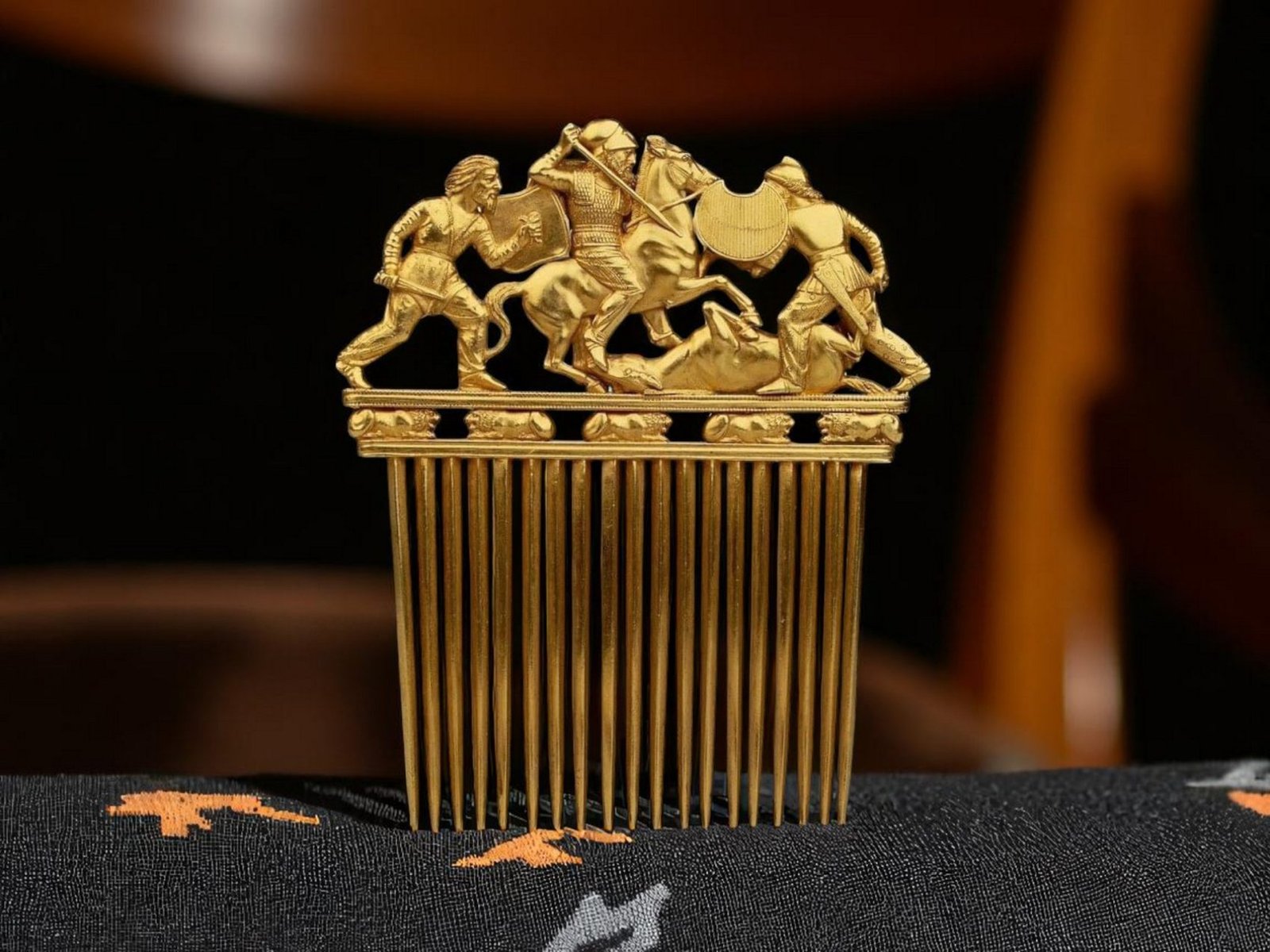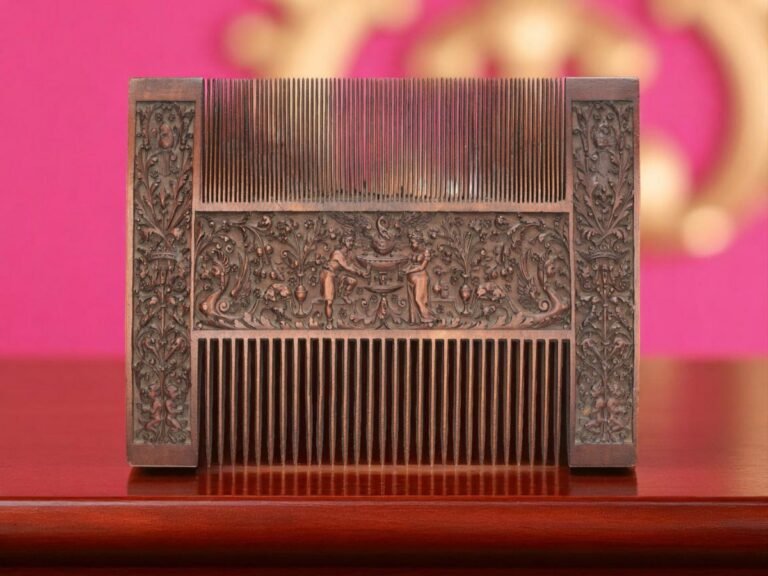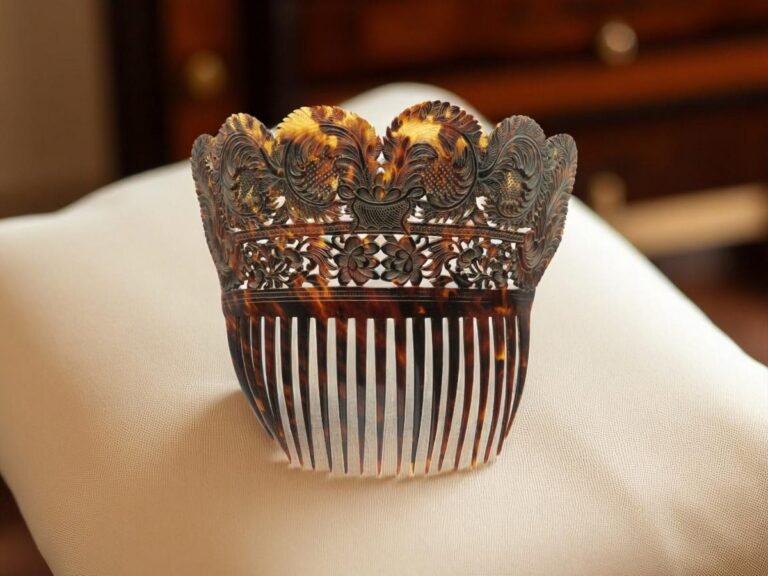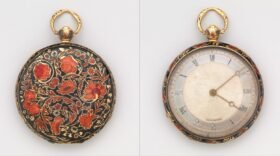
21 Jun The Decorative Comb as History, Fashion & Art
Seen Above: An Antique Solid Gold Comb Honoring a Battle in the Ancient Region of Scythia.
Let’s take a moment to appreciate something easily overlooked: the humble hair comb. Today, it’s a tool we might toss in a drawer or glove compartment. But for thousands of years, combs (especially decorative ones) have been much more than grooming instruments. They’ve been symbols of power, beauty, artistry, and cultural identity — crafted by the very same artisans who were recognized for their fine jewelry creations.
That is why if you are fortunate enough to have an antique decorative comb, and wish to sell it, the best place to visit isn’t an antique store but a San Diego estate jeweler, like C. Blackburn Jewelers, who can better understand the craftsmanship of the comb and its resale value on the estate market.
Text us a message, with photos of your decorative comb, to get started with a preliminary appraisal. Then schedule a time to visit our La Jolla jewelry store. Text your info to: 619-723-8589.
History of Antique Decorative Combs
Decorative combs date back at least 5,000 years, with early examples found in Mesopotamia, ancient Egypt, China, and beyond. These weren’t crude tools. They were hand-carved from materials like bone, ivory, wood, and shell, often adorned with patterns or imagery tied to religious or cultural beliefs.
In ancient Egypt, combs were not only functional but also spiritual objects, commonly placed in tombs to accompany the dead into the afterlife. Egyptian combs made of ivory were intricately carved with animals, deities, or hieroglyphs — marking status, protection, or divine favor.
Across the world in ancient China, jade and ivory combs were prized possessions. The act of combing the hair was often ritualistic, believed to bring harmony, stimulate qi (life energy), and strengthen personal balance. Combs were given as gifts in rites of passage and weddings, symbolizing affection and good fortune.

18th Century Combs: Power, Powder, and Prestige
Fast-forward to 18th-century Europe, and we enter a period of high fashion and even higher hairstyles. In the courts of Louis XV and Louis XVI, hair became a dramatic canvas — elaborate powdered wigs and upswept styles sometimes reached over a foot high. These hairstyles were not only theatrical but political, signaling class, allegiance, and wealth.
To anchor and embellish these constructions, decorative combs played a key role. These were often made from tortoiseshell, ivory, silver, or gold, and finely engraved or pierced with designs like scrolls, floral garlands, or allegorical scenes. Some were set with semi-precious stones or mother-of-pearl inlay.
While men wore simpler styles, women used combs both as structural supports and artistic flourishes — turning the back of the head into a stage for elegance and excess.
19th Century Combs: Sentiment and New Materials
The Victorian era (1837–1901) brought a sweeping cultural shift. Hairstyles became softer, more romantic, and increasingly sentimental. Combs were no longer just aristocratic luxuries — they became cherished personal accessories with emotional depth.
Mourning and Memory
One of the more poignant uses of decorative combs in the 19th century was in mourning fashion. After the death of Prince Albert in 1861, Queen Victoria popularized elaborate mourning customs. Black combs made of jet, gutta-percha, or ebonized wood were worn during periods of bereavement. Some combs even incorporated woven human hair as a memorial element.
Industrial Influence
With the advent of mass production and new materials, combs became accessible to the growing middle class. Celluloid, introduced in the 1860s, was a game changer: it could mimic the look of ivory or tortoiseshell at a fraction of the cost. Manufacturers like Faux Parisien and American firms like Goody began producing decorative combs that blended craftsmanship with affordability.
These combs often featured pierced work, etched designs, or repoussé metal accents. Styles were influenced by global exhibitions and the expanding influence of Asian aesthetics, especially Japanese and Indian motifs.

Art Nouveau Combs as Wearable Art
At the dawn of the 20th century, the Art Nouveau movement redefined what personal adornment could be. Designers saw no boundary between art and utility. Everything from a brooch to a hair comb could express beauty, nature, and imagination.
The comb became a canvas. Master artisans like René Lalique and Lucien Gaillard elevated the form, creating fantastical pieces from horn, ivory, mother-of-pearl, and precious metals. They sculpted ethereal figures, butterflies, peacocks, and flowers with flowing lines and dreamlike detail, often accented with enamel, opals, or moonstone.
These combs weren’t just accessories. They were status pieces, often signed, exhibited, and collected like fine art. Women wore them proudly, whether tucked into a low chignon or rising like a crest above an elegant coiffure.
Art Deco Combs: Elegance Goes Modern
By the 1920s, hair fashions had shifted again. Women were cutting their hair short — embracing the bob and the freedom it symbolized. The comb evolved in response: smaller, sleeker, and attuned to the angular aesthetics of Art Deco.
Combs from this era featured geometric patterns, sunbursts, fan shapes, and stylized motifs. Materials included Bakelite, Lucite, and early acrylics, often accented with rhinestones, chrome, or inlaid enamel. These pieces reflected the glamour and energy of the Jazz Age — modern, streamlined, and ready to dance.

Sell an Antique Decorative Comb in San Diego
At C. Blackburn Jewelers in La Jolla, we specialize in buying antique combs that have been handcrafted in gold, silver, or platinum, especially combs that have been produced by famous fine jewelers like Tiffany & Co. or Cartier.
However, we will occasionally buy antique decorative combs fashioned in tortoiseshell, ivory, and fossilized wood, if they are intricately carved and demonstrate exceptional craftsmanship.
Give us a call at 858-251-3006 to discuss the antique decorative comb you have for sale, or text a message with photos to 619-723-8589.




